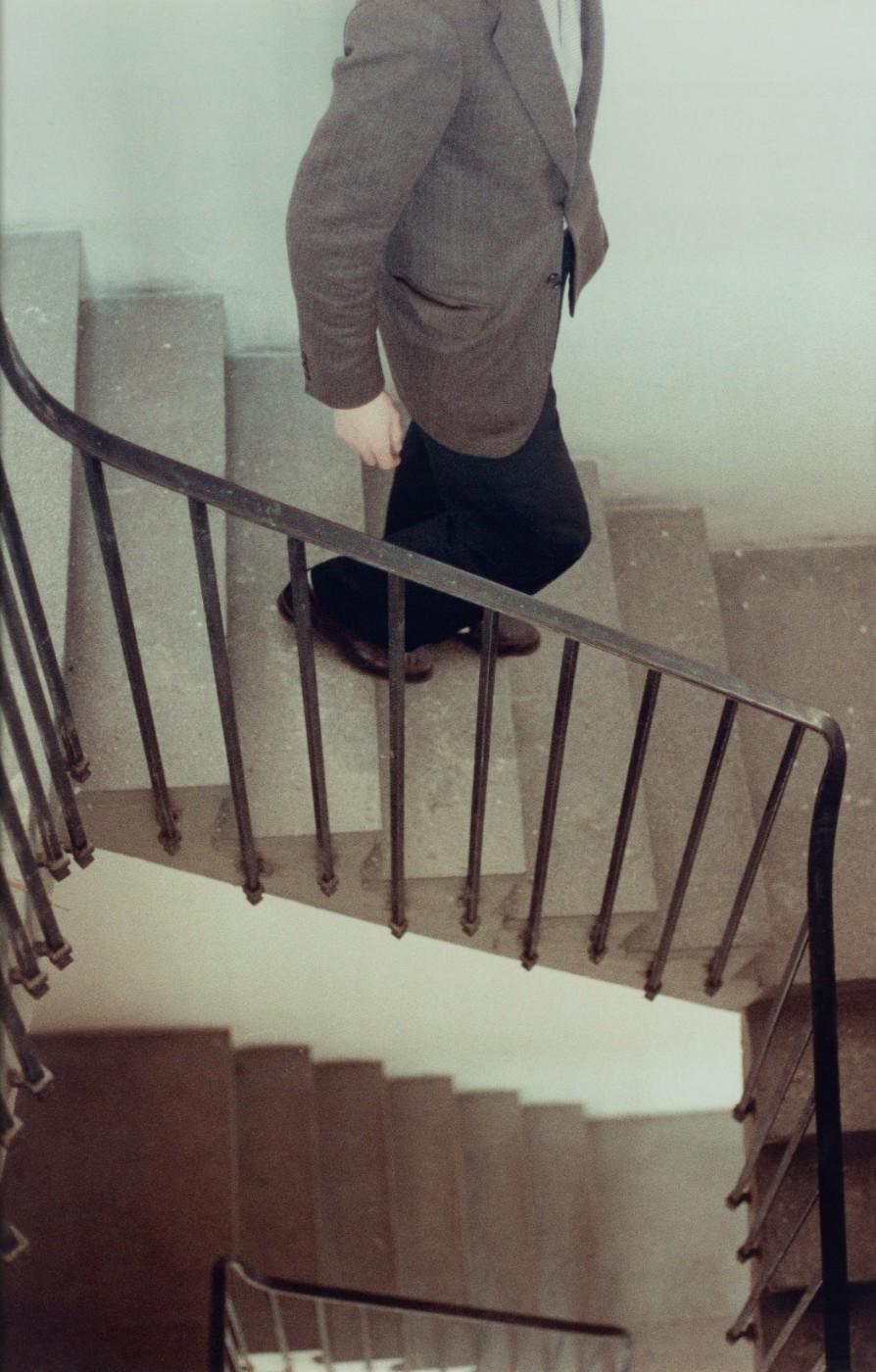A similar tension is prevalent in Förg’s sculptural work, where bronze masks flout a fine line between figuration and abstraction. Five plaster and mixed media sculptures from 2000 are featured in the exhibition. Many are composed of found household objects enshrouded in plaster, relinquishing their original forms to the amorphous plaster encasement.
Though he is most often recognized for these formal innovations, Förg also had an interest in architecture and history, as evidenced by his photographic works. Twelve photographs are featured in the exhibition, ranging in subject from portraits to modernist edifices in Italy from the 20’s and 30’s. His documentation of building elements like stairwells, windows, and portals – often depicting the artist – are framed behind reflective glass. When viewed in an installation setting and paired with framed mirrors of the same scale, these works mimic architectural features and create interruptions within the space. As with all of Förg’s work and installations, the individual works are regarded as part of a whole, merging photography with wall paintings and sculpture to activate a space with specificity to site.
Concluding the exhibition is a group of the artist’s late works, Förg’s Spot Paintings from 2007 to 2008, signaling his return to painting to manifest the expressive freedom he allowed himself towards the end of his life. These distinctive paintings feature large swathes of color on white ground, which lay bare the artist’s gesture and emphasize the activity of painting itself.
Günther Förg: A Fragile Beauty will be accompanied by a full color, 250-page catalogue designed by Joseph Logan and distributed by Yale University Press. The catalogue will be the first major publication dedicated to the artist since his passing in 2013, and includes contributions by Kirsty Bell, Gavin Delahunty, Lisa Le Feuvre, Liam Gillick, Megan Luke, Lauren Richman, Beatrix Ruf, Jeffrey Saletnik and Matthew Witkovsky. The exhibition catalogue is underwritten by Editions Traverses Sàrl.
Concurrent with this exhibition, the DMA will present a special installation of works by German artists in the Museum’s collection to contextualize Förg’s practice. Over the past 25 years, the Dallas Museum of Art has emerged as a leading US institution in collecting and exhibiting postwar German art. Förg’s work was featured in the Museum’s Encounters series in 1992, and solo exhibitions of German artists Sigmar Polke and Thomas Struth followed in the decade to come. These years also saw the exponential growth of Museum holdings in this area. This installation brings together a selection of editions and paintings by Gerhard Richter, including three new acquisitions, along with works by Polke, Struth, and Jörg Immendorf. The Richter editions and Struth photograph on view came into the collection through the support of TWO x TWO for AIDS and Art, a fundraiser that equally benefits the DMA’s contemporary collection and amfAR, The Foundation for AIDS Research, and this year marks the twentieth anniversary of that fundraiser.
Günther Förg: A Fragile Beauty is co-organized by the Dallas Museum of Art in collaboration with the Stedelijk Museum Amsterdam. The exhibition catalogue is underwritten by Editions Traverses Sàrl. Major support for the Dallas presentation is made possible by Deutsche Bank and Audi. Additional generous support is provided by the TWO x TWO for AIDS and Art Fund; the DMA Contemporary Art Initiative; Hauser & Wirth; the Kadre Family; Galerie Gisela Capitain, Cologne; Massimo De Carlo, Milan | London | Hong Kong; Galerie Bärbel Grässlin, Frankfurt Main; Greene Naftali, New York; Galerie Max Hetzler, Berlin | Paris; Gió Marconi, Milan; and Almine Rech Gallery, Paris | Brussels | London | New York.
“The Deutsche Bank Collection is one of the most substantial collections of international contemporary works on paper and photography. As a collector of Förg’s work for over 30 years, we are proud to serve as a Major Sponsor and lender to this new exhibition,” said Michael Jacoby, Managing Director, Deutsche Bank Wealth Management. Thorsten Strauss, Deutsche Bank’s Global Head of Art, Culture & Sports added: “Our corporate collection serves as an important platform for us to promote cultural diversity, inspire innovation, and provide access to quality arts experiences around the globe.”
About Günther Förg
Günther Förg was born in 1952 in Füssen, Allgäu, Germany, and studied at the Academy of Fine Arts in Munich between 1973 and 1979. During his years at the Academy, he created almost exclusively monochromatic work, contrary to the brightly saturated abstract series for which he is most known. In the 1980s, he began experimenting with photography in addition to his paintings, sculptures, and graphics, focusing on capturing international Bauhaus architecture. He pioneered a cross-disciplinary approach that often engaged several types of media, tackling the latent instability between image and reality through the abstract. In addition to the Dallas Museum of Art and the Stedelijk Museum, Amsterdam, Förg had his work exhibited at documenta IX; Deichtorhallen, Hamburg, Germany; Langen Foundation, Neuss, Germany; Kunstmuseum, Basel, Switzerland; Kunsthalle, Bremen, Germany; Tel Aviv Museum of Art, Israel; Deutsche Guggenheim, Berlin, Germany; Musée d’art moderne de la ville de Paris, France; and Touko Museum of Contemporary Art, Tokyo, Japan.































